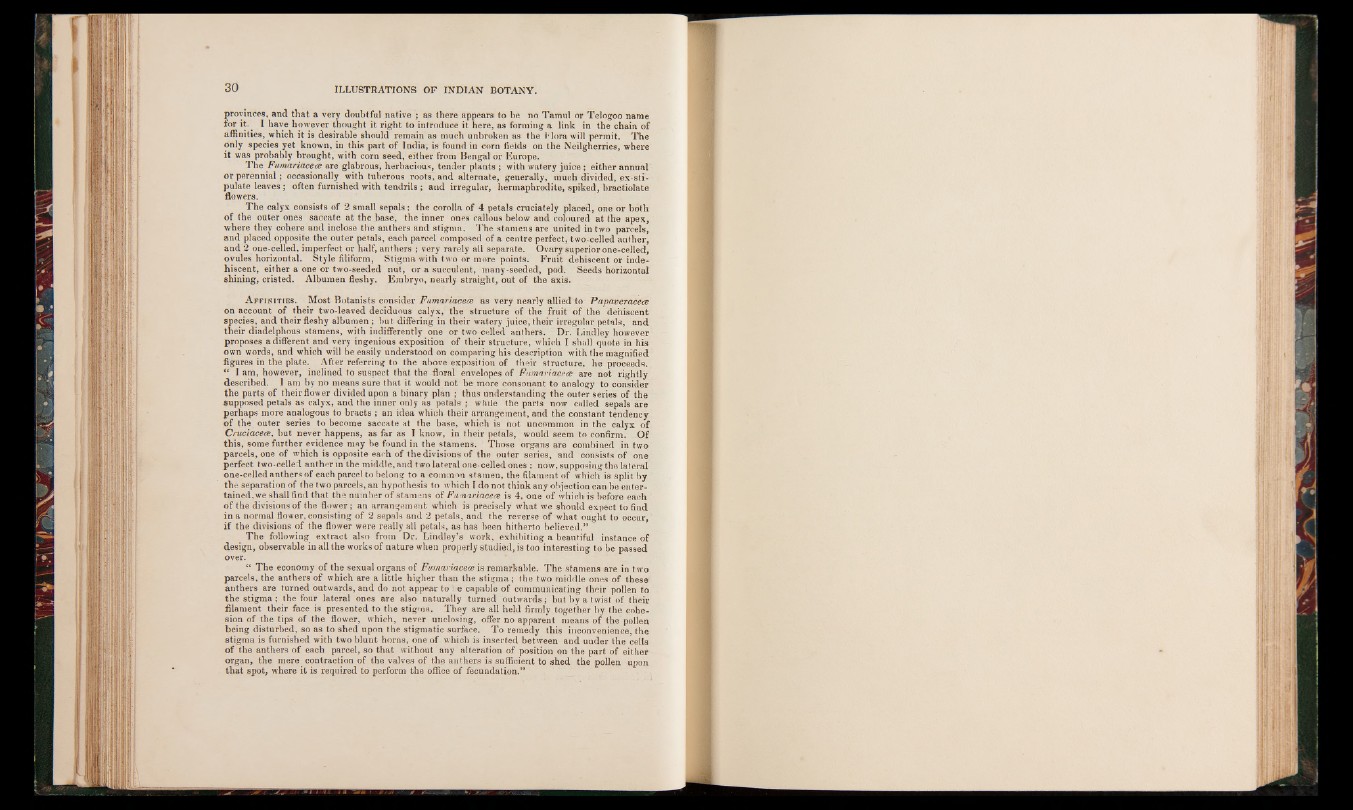
provinces, and that a very doubtful native ; as there appears to be no Tamul or Telogoo name
for it. I have however thought it right to introduce it here, as forming a link in the chain of
affinities, which it is desirable should remain as much unbroken as the flora will permit. The
only species yet known, in this part of India, is found in corn fields on the Neilgherries, where
it was probably brought, with corn seed, either from Bengal or Europe.
The Fumariacece are glabrous, herbacious, tender plants ; with watery juice ; either annual
or perennial; occasionally with tuberous roots, and alternate, generally, much divided, ex-sti-
pulate leaves; often furnished with tendrils ; and irregular, hermaphrodite, spiked, bractiolate
flowers.
The calyx consists of 2 small sepals: the corolla of 4 petals cruciately placed, one or both
of the outer ones saccate at the base, the inner ones callous below and coloured at the apex,
where they cohere and inclose the anthers and stigma. The stamens are united in two parcels,
and placed opposite the outer petals, each parcel composed of a centre perfect, two-celled anther,
and 2 oue-celled, imperfect or half, anthers ; very rarely all separate. Ovary superior one-celled,
ovules horizontal. Style filiform, Stigma with two or more points. Fruit dehiscent or inde-
hiscent, either a one or two-seeded nut, or a succulent, many-seeded, pod. Seeds horizontal
shining, cristed. Albumen fleshy. Embryo, nearly straight, out of the axis.
A f f in it ie s . Most Botanists consider Fumariacece as very nearly allied to Papaveracece
on account of their two-leaved deciduous calyx, the structure of the fruit of the dehiscent
species, and their fleshy albumen ; but differing in their watery juice, their irregular petals, and
their diadelphous stamens, with indifferently one or two celled anthers. Dr. Lindley however
proposes a different and very ingenious exposition of their structure, which I shall quote in his
own words, and which will be easily understood on comparing his description with the magnified
figures in the plate. x\fter referring to the above exposition of their structure, he proceeds.
** I am, however, inclined to suspect that the floral envelopes of Fumariacece are not rightly
described. I am by no means sure that it would not be more consonant to analogy to consider
the parts of their flower divided upon a binary plan ; thus understanding the outer series of the
supposed petals as calyx, and the inner only as petals ; while the parts now called sepals are
perhaps more analogous to bracts ; an idea which their arrangement, and the constant tendency
of the outer series to become saccate at the base, which is not uncommon in the calyx of
Cruciacece, but never happens, as far as I know, in their petals, would seem to confirm. Of
this, some further evidence may be found in the stamens. Those organs are combined in two
parcels, one of which is opposite each of the divisions of the outer series, and consists of one
perfect two-celled anther in the middle, and two lateral one-celled ones : now, supposing the lateral
one-celled anthers of each parcel to belong to a common stamen, the filament of which is split by
the separation of the two parcels, an hypothesis to which I do not think any objection can be entertained,
we shall find that the number of stamens of Fumariacece is 4, one of which is before each
of the divisions of the flower; an arrangement which is precisely what we should expect to find
in a normal flower, consisting of 2 sepals and 2 petals, and the reverse of what ought to occur,
if the divisions of the flower were really all petals, as has been hitherto believed.”
The following extract also from Dr. Lindley’s work, exhibiting a beautiful instance of
design, observable in all the works of nature when properly studied, is too interesting to be passed
over.
“ The economy of the sexual organs of Fumariacece is remarkable. The stamens are in two
parcels, the anthers of which are a little higher than the stigma; the two middle ones of these
anthers are turned outwards, and do not appear to he capable of communicating their pollen to
the stigma; the four lateral ones are also naturally turned outwards; but by a twist of their
filament their face is presented to the stigma. They are all held firmly together by the cohesion
of the tips of the flower, which, never unclosing, offer no apparent means of the pollen
being disturbed, so as to shed upon the stigmatic surface. To remedy this inconvenience, the
stigma is furnished with two blunt horns, one of which is inserted between and under the cells
of the anthers of each parcel, so that without any alteration of position on the part of either
organ, the mere contraction of the valves of the anthers is sufficient to shed the pollen upon
that spot, where it is required to perform the office of fecundation.”